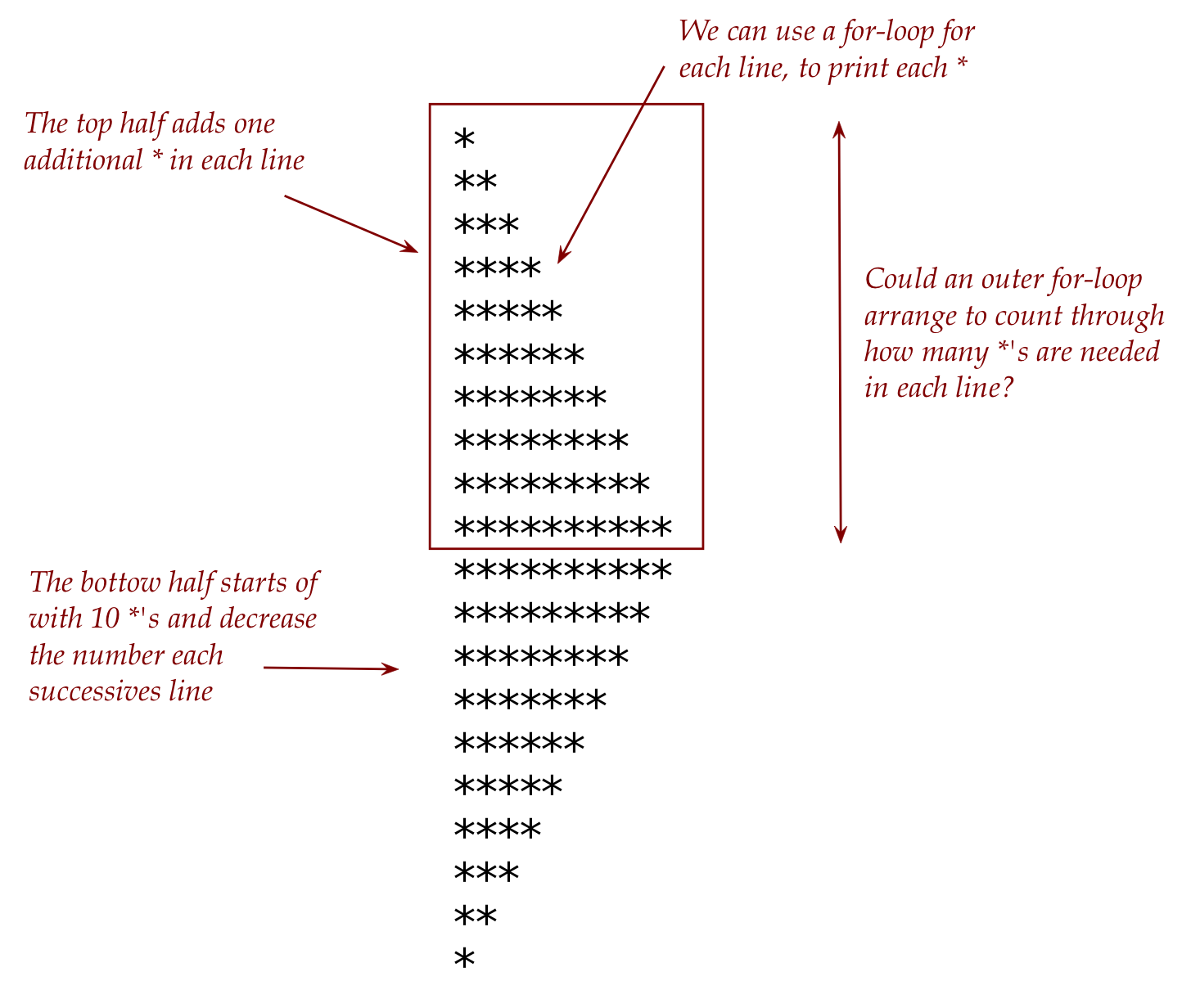Let's start by examining the output more closely:

Let's try to get the top half of the arrowhead first:
- At first, let's not worry about the details of the start/end of loops.
- As a "sketch" (not real code) we could write:
for i in range(... to be determined ...): # Print i *' - Next, examine the problem of printing i asterisks on a single line.
- If we just had print, say, 7 asterisks on a line, could we write a for-loop to do that?
- Does this sketch work?
for j in range(... something to do with 7 ...): print('*') - Now let's work out the range: we want to run from either 1 through 7 (inclusive) or from 0 through 6.
- Suppose we pick the 0 through 6 option and write:
for j in range(0,7): print('*') - At this point we can try this and see what it does.
A1.1 Exercise: Write up the above in my_demo_problem1.py. What went wrong? Explain in your assignment1.pdf.
- Now let's generalize to printing a single line of i asterisks:
for j in range(0,i): print('*', end='') - Next, we can use this as our inner loop in the
overall top-half sketch:
for i in range(... to be determined ...): # Print i *'s for j in range(0,i): print('*', end='') - Now let's determine the range of i (which we might get wrong the first try, but can fix easily).
- We sense that the limit is 10. Could the following work?
for i in range(1, 10): # Print i *'s for j in range(0,i): print('*', end='')
A1.2 Exercise: Write up the above in my_demo_problem2.py. What went wrong? Explain in your assignment1.pdf.
- Let's fix the issue. We need to get to a new line every time the inner loop completes.
- Does this work?
for i in range(1, 10): # Print i *'s for j in range(0,i): print('*', end='') print()
A1.3 Exercise: Write up the above in my_demo_problem3.py. What went wrong?
- Next, we'll fix and write:
for i in range(1, 10): # Print i *'s for j in range(0,i): print('*', end='') print() - Does this work?
A1.4 Exercise: Write up the above in my_demo_problem4.py. What went wrong?
- We now have the solution to the top half:
for i in range(1, 11): # Print i *'s for j in range(0,i): print('*', end='') print()
Next, let's tackle the bottom half:
- Again, we see that each particular line prints a number of *'s.
- As long as we can figure out how many are needed in each line, we can reduce each line by 1.
- That suggests an outer loop that starts big and grows small.
- Let's sketch this out as:
# Code for top half here ... # Code for bottom half: for i in range(... to be determined ...): # Print i *' - But we already know how to print i *'s because we
solved that in the top half:
# Code for top half here ... # Code for bottom half: for i in range(... to be determined ...): # Print i *' for j in range(0,i): print('*', end='') print() - So all that's left is to determine the range of i so that it starts at 10 and goes down to 1.
- Since going down in a range requires a negative step, we
could write something like
for i in range(10, 1, -1): - Clearly, we want to start at 10. But should the range end with 1 or 0? We'll leave this unanswered for now.
- Let's put it all together:
# Code for top half: for i in range(1, 11): for j in range(0, i): print('*', end='') print() # Code for bottom half: for i in range(10, 1, -1): for j in range(0, i): print('*', end='') print()
A1.5 Exercise:
Write up the above in
my_demo_problem5.py.
Did it work?
Submit your final version in
my_arrowhead.py.